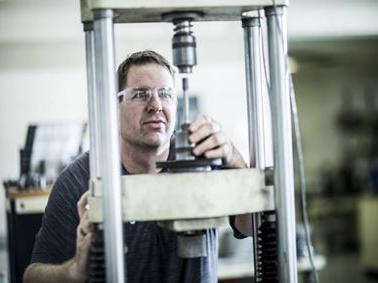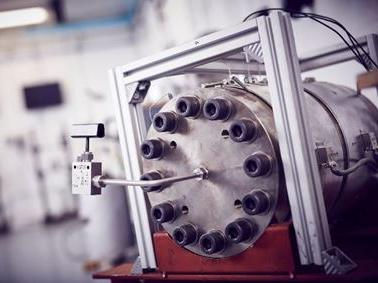When aspects of design, construction, and operation fall outside the embedded knowledge of recognized design and construction codes or specifications, an alternative approach is required. Element provides Engineering Critical Assessment (ECA) based on fracture mechanics to allow engineers to demonstrate the safety of a structure or a component and reduce the probability of failure in engineering structures.
From design to construction and operation, Element applies engineering critical assessment techniques to a wide range of welded structures. Our fully integrated and advanced consultancy, testing, and analysis services evaluate the defect tolerance for plastic collapse, fracture, and fatigue damages of safety-critical items in all-welded structures and components like pipelines, pressure vessels, drilling rigs, platforms, and wind turbines which are exposed to various challenging environmental and operating conditions.
By including further criteria in the evaluation, an ECA goes beyond the conventional testing of welded joints based on recognized standards. Among other things, the following are taken into account:
- Properties of the defect (size, location, and orientation),
- The occurring mechanical loads including all cyclic and static loads as well as environmental conditions (direction, strength, temperature) around the flaw,
- The material properties (toughness, tensile strength) in the vicinity of the defect.
The overall consideration often results in higher defect tolerances than individual defects. This will reduce costs and time spent on unnecessary repairs and help prevent failures.
Engineering Critical Assessment applicable scenarios
Element's fully integrated and advanced consultancy, testing and analysis services support the following scenarios:
- Determine flaw acceptance criteria for welded structures to demonstrate the critical dimensions of a fabrication flaw with which the structure can safely operate.
- Evaluate structural investigation results and assess the severity of the detected flaws.
- Evaluate and assess for detecting and sizing the flaw, which can jeopardize the integrity of a structure.
- Assess the necessity of applying a Post Weld Heat Treatment (PWHT) on a welded section.
- Perform a failure analysis investigation and evaluate the plausibility of a failure scenario.
Our Engineering Critical Assessment services
Element offers ECA analyses according to several internationally recognized codes and standards, such as BS7910, DNV-OS-F101, DNVGL-RP-F108, and API 1104. This includes:
- Consultancy on testing requirements and analysis regimes,
- Dynamic and quasi-static fracture mechanics testing and analysis in ambient and simulated environmental conditions, e.g. Hydrogen loaded, corrosive media, or cryogenic temperatures, to a vast majority of internationally recognized codes and standards,
- Material mechanical treatment in small scale straining, full-scale straining, and aging treatments, full-scale simulated pipe reeling,
- Fatigue crack growth rate measurement and analysis,
- Mechanical testing at elevated and cryogenic temperature.
Fully integrated services for ECA
Element’s multidisciplinary approach and expertise in materials engineering, fracture and fatigue analysis, stress analysis, and NDT inspection successfully deliver an Engineering Critical Assessment to a variety of internationally recognized codes and standards. We combine our advanced materials testing facilities in the US, UK, Europe, and Middle East Asia Pacific (MEAP) with our fully integrated ECA services to help you define the most cost-effective inspection and repair plan for all your projects during design, installation, and operation.
ECA for offshore pipelines
In offshore pipeline welding, a critical engineering assessment can, in theory, relax the weld flaw acceptance criteria, although this is not always the case. Engineering critical assessment takes into account the installation and operational phases of the pipeline, as the installation methods become more complex, and the operational conditions become more onerous, engineering critical assessment based Fitness For Service (FFS) acceptance criteria can sometimes be more restrictive.
Element has a proven track record and experience in assessing pipeline construction under a variety of installation methods and operational conditions that pipe-laying activities routinely encounter.
The Element advantage
Through our in-depth data and analysis within an integrated service, we ensure more reliable modeling of installation and service conditions, enabling you to make informed and confident decisions on the most appropriate remedial measures to take. Element's Engaged Experts can tailor our material testing, bespoke acquisition, and analysis routines to provide you with the highest quality data in the Energy industry.
Innovation in engineering critical assessment testing and analysis methods is constant and remains an ongoing strategic priority for Element. An integrated, internationally standardized service from our facilities with equal expertise in both the testing and assessment areas provides benefits for data and analysis accuracy, speed of delivery while giving increased confidence in the overall integrity of engineering structures.
For more information about our ECA services, or to request a quote contact us today.
FAQ: What is an Engineering Critical Assessment (ECA)
Our experts can help deepen your knowledge about Engineering Critical Assessment and its benefits by answering some of the most frequently asked questions.
Read MoreWebinar: How to utilize Engineering Critical Assessment within the Energy industry
ECA is used in many ways, including improving welding criteria or ensuring fitness-for-service for new or existing assets. But what is ECA, where can it apply, and what are the benefits? Our on-demand webinar provides answers.
Read MoreCan an ECA mitigate the requirement of performing PWHT?
Post Weld Heat Treatment (PWHT) is applied to relax the residual stresses within welds to reduce the risk of brittle fracture. The case study looks at how Element’s energy team performed Engineering Critical Assessment (ECA) to avoid PWHT.
Related Services

Structural Testing & Mechanical Engineering
Element offers a range of advanced and application oriented engineering services to help solve a wide variety of mechanical engineering and structural engineering analysis problems.

Fitness For Service (FFS)
Element’s Fitness for Service (FFS) – AP 579/ASME FFS-1 services help determine if your equipment is safe and fit for continued operation to prevent failures, minimize risks and eliminate costly repairs.

Modeling and Simulation
We specialize in modeling and simulation to accelerate your research and development initiatives, optimize your designs and support safe, efficient operations.

Asset Integrity Management
Our asset integrity services within the Oil and Gas, Petrochemical, and Process industry ensure your critical infrastructure is safe, reliable, and operationally efficient.

